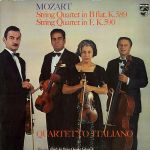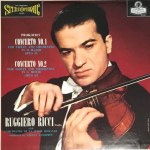
What to Listen for ask? Dryness.
Some of the copies lacked the richness to balance out the clarity and became dry sounding. There is a balance to be found. The right VTA will be critical in this regard. When you have all the space; the clearest, most extended harmonics; AND good weight and richness in the lower registers of the cello, you are where you need to be (keeping in mind that it can always get better if you have the patience and motivation to tweak further).
On the other side of that coin is smear, usually from too much tubey richness. Again, finding the balance is key.
Here are some other records that are good for testing string tone and texture.
OUR HOT STAMPER COMMENTARY FROM 2013
Easily one of the finest string quartet recordings we have ever had the pleasure to play, this Philips pressing earned strong grades on both sides for its lovely recreation of space, Tubey Magical richness, and rosiny string textures.
It sounds very much like live music, or at least what you imagine this music would sound like live. Of course, live classical music is shocking in its clarity and freedom from artificiality, and no recording I have ever heard duplicates that sound with perfect fidelity, but when the pressing is as clear and transparent and natural as this one, your ability to suspend disbelief seems to require no effort at all.
Close your eyes and your brain, search as it may, can find nothing in the recording to interfere with the appreciation of even the most subtle nuances of the score. This is the mark of a very fine record indeed.
You may notice that we do very few chamber music records on the site. Thousands of these works have been recorded, and to be honest a large portion of them actually have quite decent sound. Obviously a handful of instruments is much more easily captured on tape than the fifty or more pieces in a modern large orchestra.
But when we hear one with this kind of transparency and fidelity, we make every effort to track down more copies, working through them to discover the truly Hot Stamper pressings lurking within their identical looking covers.
This copy had the sound we were looking for. Those of you with exceptionally clean, clear systems, capable of reproducing both the clarity and the Tubey Magic captured on the tape, are in for a real treat.
(more…)
 Hot Stamper Pressings Featuring the Violin
Hot Stamper Pressings Featuring the Violin We have to put the records through the ringer, and one of the ringers they must go through is they must sound right at loud levels, because live music gets loud, without getting distorted or congested.
We have to put the records through the ringer, and one of the ringers they must go through is they must sound right at loud levels, because live music gets loud, without getting distorted or congested.






 The Music of Claude Debussy Available Now
The Music of Claude Debussy Available Now